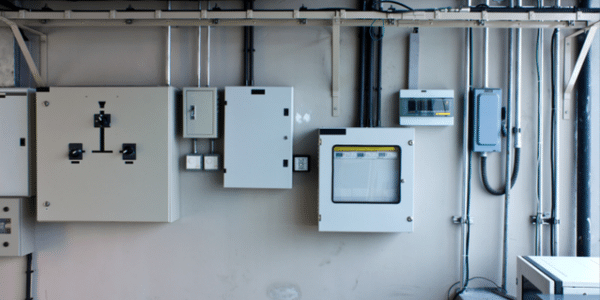Understanding the Key Features of Electrical Fiberglass Boxes for Safe and Efficient Operations
5/31/20244 min read


Electrical fiberglass boxes serve as essential components in a wide array of applications, ensuring the safe and efficient operation of electrical systems. These enclosures are crafted from fiberglass, a composite material known for its remarkable durability, lightweight properties, and non-conductive nature. This combination of attributes makes fiberglass an ideal choice for housing electrical components, offering protection against environmental factors and electrical interference.
Fiberglass is composed of fine fibers of glass that are woven together and bonded with a resin, creating a robust and resilient material. This process results in electrical fiberglass boxes that can withstand harsh conditions, including exposure to chemicals, moisture, and extreme temperatures, without degrading. The non-conductive properties of fiberglass also enhance safety by preventing electrical currents from escaping the enclosure and posing a hazard to users.
There are various types of electrical fiberglass boxes available in the market, each designed to cater to specific needs and requirements. Junction boxes are commonly used to house and protect electrical connections, ensuring that they remain secure and free from damage. Wall-mounted enclosures provide a convenient solution for organizing and safeguarding electrical components in both residential and commercial settings. Underground boxes, on the other hand, are designed to protect electrical connections and equipment installed below ground level, offering a reliable barrier against soil, water, and other environmental elements.
Understanding the foundational aspects of electrical fiberglass boxes is crucial for anyone involved in the installation, maintenance, or operation of electrical systems. With their unique combination of durability, lightweight structure, and non-conductive properties, these enclosures play a vital role in promoting the safe and efficient functioning of electrical components across diverse applications. As we delve deeper into the specific features and benefits of electrical fiberglass boxes, it becomes evident why they are a preferred choice in many industries.
Electrical fiberglass boxes offer a range of features that make them highly desirable for various industrial applications. One of the most significant advantages is their high resistance to corrosion. Unlike metal enclosures, fiberglass does not rust or degrade when exposed to harsh environmental conditions, such as saltwater or chemicals. This makes them particularly suitable for use in coastal areas or in industries like chemical processing and wastewater treatment.
Another key feature is their resistance to UV radiation and extreme temperatures. Fiberglass boxes can withstand prolonged exposure to sunlight without becoming brittle or discolored, making them ideal for outdoor installations. Additionally, they maintain their structural integrity in both high and low-temperature environments, ensuring reliable performance even in the most demanding settings.
The non-conductive nature of fiberglass is another critical benefit. This property significantly enhances safety by reducing the risk of electrical shocks, making these boxes an excellent choice for electrical and telecommunications applications. Their non-conductivity also prevents the occurrence of short circuits and electrical faults, contributing to safer operational environments.
Moreover, electrical fiberglass boxes are lightweight, which simplifies the installation process. Their light weight not only makes them easier to transport and handle but also reduces the overall labor and equipment costs associated with installation. This is particularly beneficial in large-scale projects where time and cost efficiency are paramount.
In terms of maintenance, fiberglass enclosures require minimal upkeep. Their robust construction and resistance to environmental factors mean that they do not need frequent repairs or replacements. This long-term durability translates into lower operational costs and reduced downtime, which are critical considerations for any industry.
Real-world examples of these benefits can be seen in various sectors. For instance, in the telecommunications industry, fiberglass boxes are used to house sensitive equipment, protecting it from external elements and ensuring uninterrupted service. Similarly, in the renewable energy sector, these boxes safeguard electrical components in solar and wind power installations, contributing to the overall efficiency and reliability of the system.
Applications and Best Practices for Using Electrical Fiberglass Boxes
Electrical fiberglass boxes are essential components in a wide range of applications due to their superior durability, corrosion resistance, and electrical insulation properties. These characteristics make them suitable for various settings, including residential, commercial, and industrial environments.
In residential settings, electrical fiberglass boxes are often used for housing electrical connections, circuit breakers, and other critical components. Their non-conductive nature enhances safety by preventing electrical shocks, making them ideal for home electrical systems. In commercial buildings, these boxes provide reliable protection for complex electrical wiring and equipment, ensuring uninterrupted power supply and operational efficiency.
Industrial applications, however, present more demanding conditions where electrical fiberglass boxes excel. For instance, in telecommunications, these boxes safeguard sensitive electronic devices and wiring from environmental hazards such as moisture and extreme temperatures. Water treatment facilities also benefit from using fiberglass boxes due to their resistance to chemicals and water, ensuring the longevity and reliability of the electrical components housed within.
Renewable energy projects, including solar and wind farms, rely heavily on electrical fiberglass boxes. These installations often require durable and weather-resistant enclosures to protect electrical systems from harsh outdoor environments. The robustness of fiberglass boxes makes them an excellent choice for these sustainable energy solutions.
When selecting the right type of electrical fiberglass box for a specific application, it is crucial to consider factors such as size, load capacity, and environmental conditions. Choosing a box with the appropriate NEMA rating ensures it can withstand the specific environmental challenges it will face, whether it's exposure to water, dust, or extreme temperatures.
Proper installation is another key aspect of ensuring the long-term performance of electrical fiberglass boxes. It involves securely mounting the box, using appropriate sealing techniques to prevent moisture ingress, and ensuring all connections are properly insulated. Regular maintenance, including periodic inspections and cleaning, is necessary to identify and address any potential issues before they escalate.
By understanding the diverse applications and adhering to best practices for selection, installation, and maintenance, users can maximize the benefits of electrical fiberglass boxes, ensuring safe and efficient operations across various industries.
